This is a nifty site that is available to teachers and schools worldwide. The site explains how Museum Box
provides the tools for you to build up an argument or description of an event, person or historical period by placing items in a virtual box. What items, for example, would you put in a box to describe your life; the life of a Victorian Servant or Roman soldier; or to show that slavery was wrong and unnecessary? You can display anything from a text file to a movie. You can also view and comment on the museum boxes submitted by others.

The site also explains how
You can add text, images, video and sound to the side of the cubes. To save your box you will need to register. For teachers there is lesson guidance and instructions for use are available in the Teachers Area and you can Register your school.
Anyone can view the Museum Boxes, but if you wish to make and save your own box, it does require registration, which is approved (in my case) in about five days.
What an engaging way of putting together resources on a historical (or any) topic.
Thanks to Richard Byrne from Free Technology for Teachers for alerting Bright Ideas to Museum Box!





